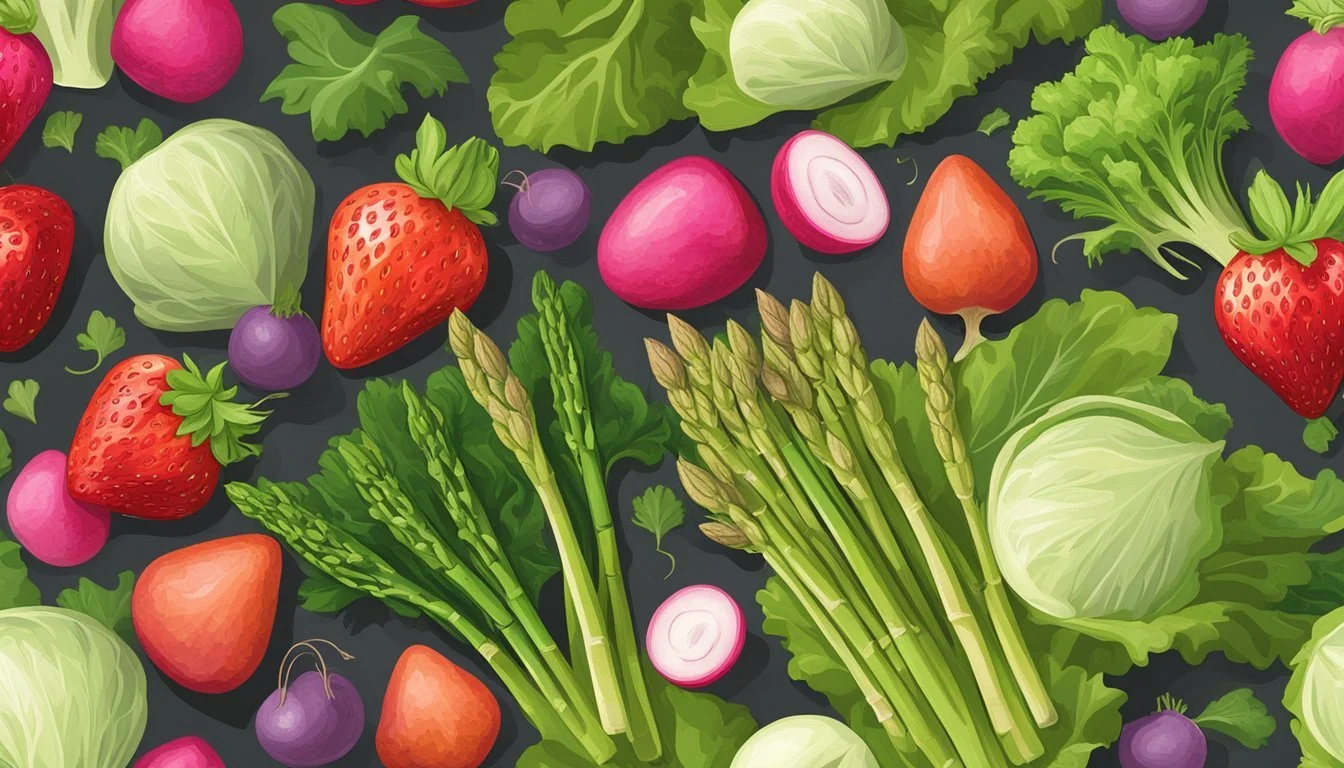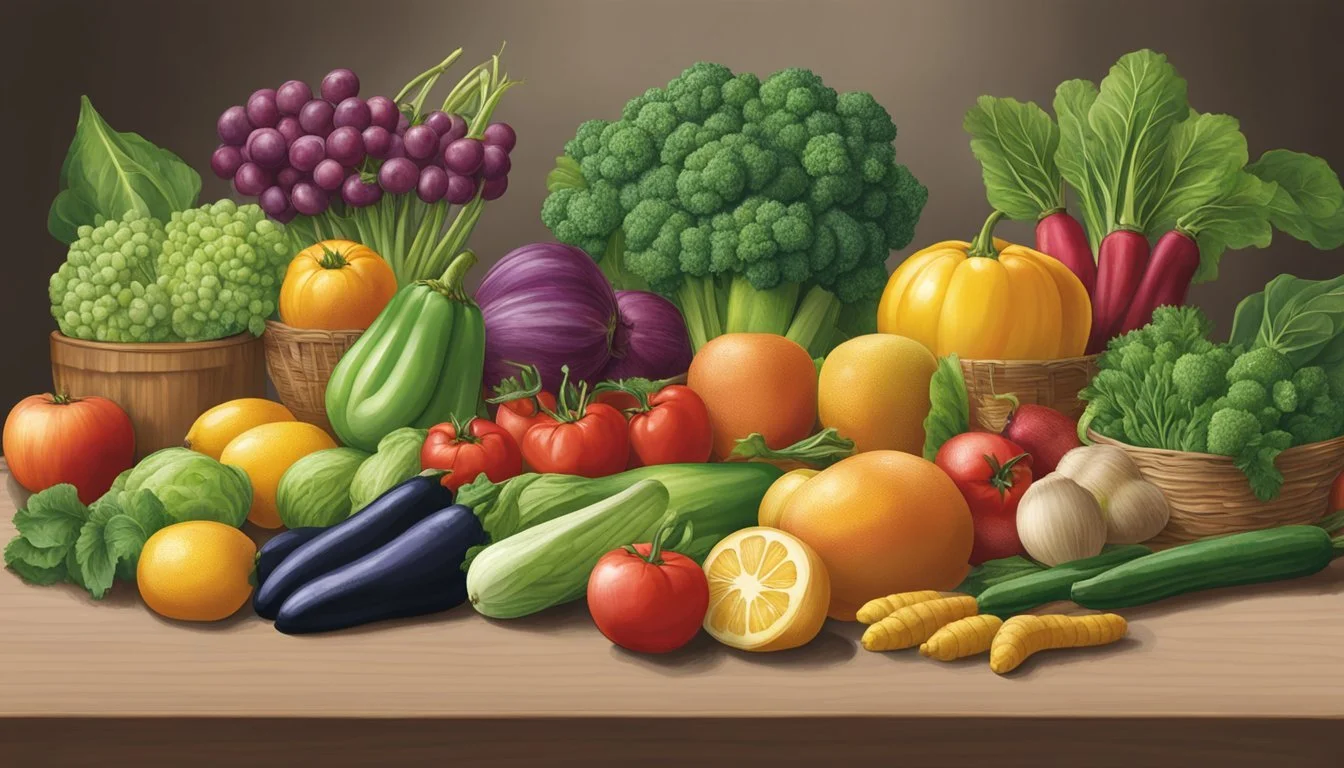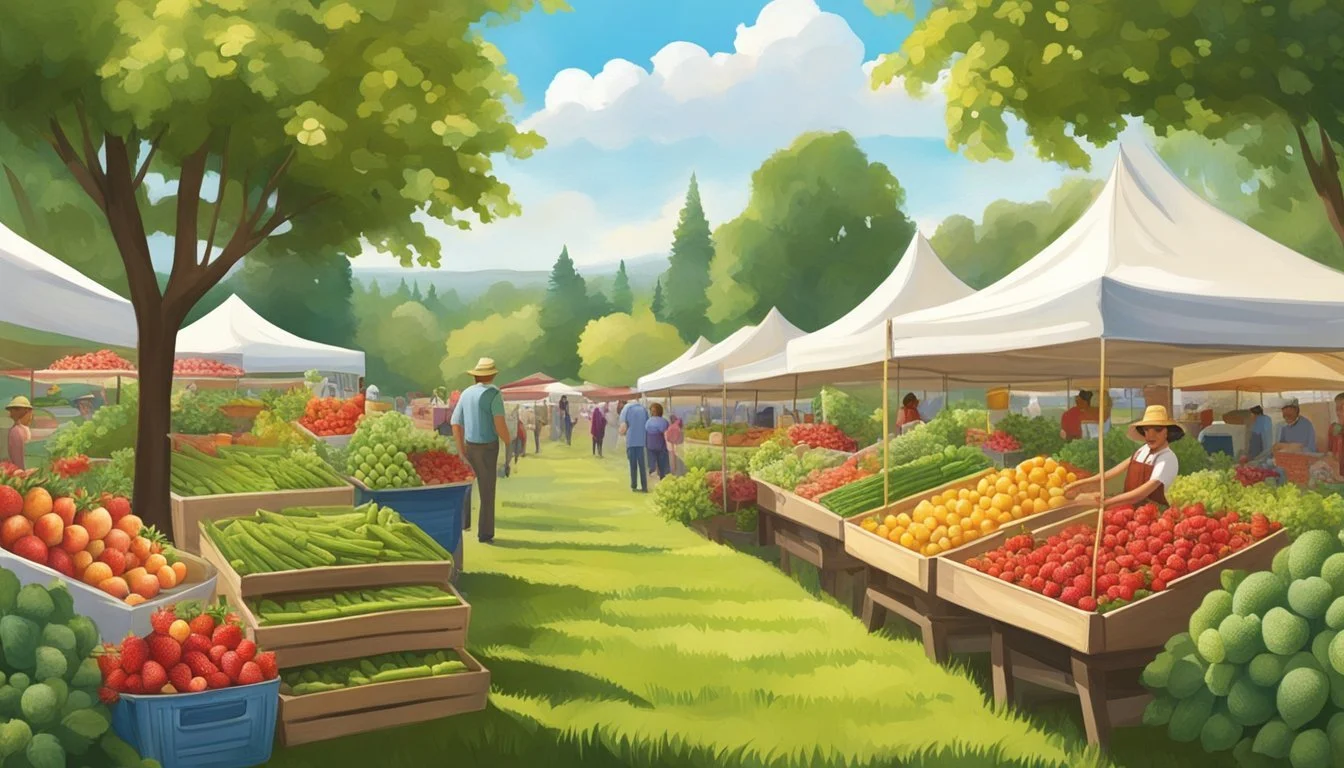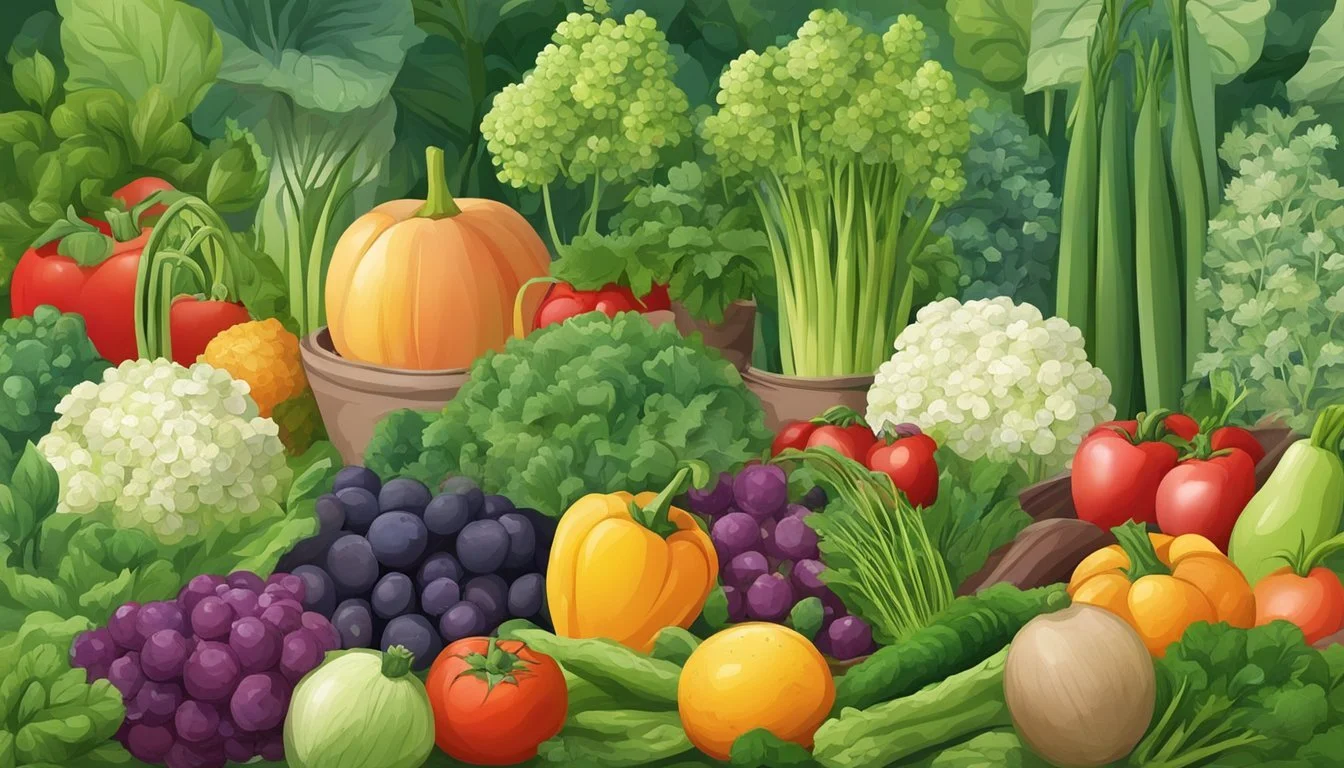Wisconsin Seasonal Fruit & Vegetables in April
A Guide to Local Produce
This Article is Part of our Wisconsin Seasonal Fruit & Veg Calendar
As the frost of winter melts away, Wisconsin's farmlands begin a slow awakening in April. The state's diverse climate, with cold winters and warm summers, sets the stage for the growth of a variety of fruits and vegetables. It's a transitional month, where the earliest signs of spring herald the start of a fresh produce season. While the selection isn't as abundant as in the peak summer months, April offers its own unique bounty that residents look forward to.
The seasonal rhythm in Wisconsin means April is typically associated with the initial harvest of cool-weather crops. Farmers and gardeners in the Badger State start to see the fruits of their labor with the appearance of asparagus (how long does asparagus last?)spears poking through the soil. This early spring vegetable is one of the first to be available, often eagerly anticipated for its fresh, earthy flavor and versatility in dishes. Rhubarb, another resilient perennial, also makes its debut, hinting at the sweet and tart treats to come as the season progresses.
Leafy greens such as arugula begin to thrive in the cool April weather, providing a peppery kick to salads and sandwiches. These early greens are just a preview, as the state's rich soil and ample freshwater sources lay the groundwork for an extensive range of produce to flourish as spring turns into summer. For now, the focus is on the fresh, crisp flavors that April's harvest brings to the tables across Wisconsin, setting a verdant scene for the abundance that the coming months promise.
Understanding Wisconsin's Growing Season
In the spring, Wisconsin's growing season begins to unfold. Although April in Wisconsin can still be quite cool with occasional frost, the onset of longer daylight hours and gradually warming temperatures signals the start of growth for a variety of crops.
Spring weather in Wisconsin is characterized by variability, with temperatures ranging from cool to warm, and precipitation that can include both rain and late snowfalls. This presents both challenges and opportunities for farmers and gardeners as they prepare for the planting season.
The Typical Spring Timeline:
Early April: Cold-tolerant plants and early starters are sown, but with protective measures against frost.
Mid to Late April: As the soil warms, more varieties of plants are sown or transplanted outdoors.
Factors Affecting the Growing Season:
Weather: Critical, with temperature and precipitation directly influencing planting times and crop success.
Soil Conditions: Warmer soil temperatures allow for the seeding of a broader range of vegetables and fruits.
Common Early Season Crops:
Vegetables: Lettuce, spinach (What wine goes well with spinach?), radishes, and peas often are planted as they can tolerate cooler temperatures.
Fruits: While most fruit crops are not harvested until later in the season, preparation of orchards and berry patches occurs.
Wisconsin's season is relatively short compared to warmer regions, making it crucial for farmers to optimize planting schedules and select crops that can thrive in the state's distinct climate. Understanding the nuances of Wisconsin's spring is essential for successful cultivation.
Key Fruits and Vegetables in April
In April, Wisconsin's gardens come to life as select fruits and vegetables reach their peak season. Shoppers should keep an eye out for these local, fresh picks at farmers markets and stores.
Fruits
April is not Wisconsin's prime time for a wide variety of fruits, as many fruit crops tend to reach harvest in late summer to early fall. However, one may find stored apples from the previous season still available, which remain a sweet treat.
Vegetables
During April, the range of in-season vegetables begins to expand. Here's a list of vegetables that Wisconsin residents can find fresh in this month:
Spinach: Known for its versatility and sweet, earthy flavor.
Rhubarb: Often found in desserts, has a tangy taste and is typically harvested in late spring.
Spring Onions: Add a fresh, sharp flavor to dishes.
Leeks: Offer a mild, onion-like taste and are perfect for adding depth to soups and stews.
These items reflect just a portion of the produce that one may find in Wisconsin during the month of April, with availability subject to change based on local conditions and farming practices.
Seasonal Harvesting and Availability in Wisconsin for April
April in Wisconsin marks a transitional month for farmers and markets, as the state begins to move from winter produce to the early offerings of spring. Crop availability is usually limited to hardier, cold-tolerant varieties and stored goods from the previous season's harvest.
Fresh Produce:
Overwintered vegetables such as parsnips and sunchokes are typically harvested during this time.
Locally produced mushrooms continue to be available.
Maple syrup (how long does maple syrup last?), a springtime staple, is fresh off its harvest, available from local producers.
Markets begin to see an influx of these items, alongside stored produce. The carryover from last season usually includes:
Root vegetables like carrots and potatoes
Apples, often kept in controlled, cold storage to maintain crispness
Onions and garlic from storage
The following table outlines the availability of typical Wisconsin produce in April:
Fresh Produce Availability Status Parsnips Harvested, available fresh Sunchokes Harvested, available fresh Mushrooms Available fresh Maple Syrup Harvested, available fresh
It's important to note that Wisconsin’s weather can influence the exact timing of crop availability. However, consumers can typically find these local goods at farmers' markets, grocery stores specializing in local produce, or through community-supported agriculture (CSA) programs. While the variety of vegetables and fruits expands significantly moving into the warmer months, April provides a glimpse into the forthcoming abundance of Wisconsin's agricultural offerings.
April's Featured Produce
April in Wisconsin marks the transition from winter to spring, offering a variety of produce that begins to flourish as the temperatures rise. This selection highlights local favorites and introduces vibrant flavors back into the diet after the colder months.
Leafy Greens
Wisconsin's April harvest brings about a fresh batch of leafy greens. Expect to find various types of lettuce and spinach making their way to the market. These greens are not only versatile but also packed with nutrients perfect for spring salads and side dishes.
Lettuce: Typically includes iceberg, romaine, and leaf lettuces.
Spinach: Look for bright, fresh leaves, a sign of seasonality and quality.
Root Vegetables
The cooler temperatures of early spring still allow for the last harvests of root vegetables. Radishes and turnips are at their peak, offering a crisp texture and a slightly peppery flavor, ideal for adding a fresh bite to meals.
Radishes: Often found in vibrant reds and pinks.
Turnips: Can be roasted or mashed, providing a hearty addition to any meal.
Seasonal Fruits
While fruit selections in Wisconsin are more limited in early spring, there are still some seasonal fruits to enjoy. Rhubarb stands out in April, often used in desserts for its tart flavor. It’s important to note that while not harvested fresh in April, stored apples from the previous season are commonly available and retain much of their flavor and crispness.
Rhubarb: A tart vegetable often used as a fruit in sweet applications.
Apples: Storage varieties like the Fuji or Granny Smith may still be available for purchase.
Farmers Markets and Local Produce
In Wisconsin, farmers markets become vibrant community hubs in the spring. They offer a platform for local producers to bring their fresh, seasonal produce directly to consumers. Buyers can expect to find a variety of April offerings such as spinach, radishes, and the early shoots of asparagus. These markets not only provide access to fresh food but also help strengthen the local economy.
Spinach
Availability: Common in early spring
Note: Rich in nutrients, perfect for salads
Availability: Begins in April
Note: Adds a peppery crunch to dishes
Asparagus
Availability: Late April onward
Note: Sought after for its tender stalks
Visitors to these markets can engage with growers, seeking information about the farm-to-table journey of the items they purchase. This interaction underlines the significance of local produce, which is known for its freshness and flavor compared to goods that have been transported over long distances.
Moreover, embracing local produce from farmers markets supports sustainable agricultural practices. Consumers can take solace in reducing their carbon footprint, as products travel shorter distances, thereby diminishing transport emissions.
Most Wisconsin farmers markets also celebrate the arrival of spring herbs. These often include chives, parsley, and cilantro. They provide fresh, aromatic additions to early spring dishes, hinting at the more abundant variety of produce that will follow as the season progresses.
Health Benefits of Seasonal Eating
Eating seasonally provides a range of health benefits. Fresh fruits and vegetables are at their nutritional peak when harvested in season. This means that they often contain more vitamins and antioxidants compared to out-of-season produce, which may have diminished nutrients due to long storage periods and transport.
Variety is another significant advantage of seasonal eating. It encourages the consumption of a broader spectrum of fruits and vegetables throughout the year, which helps supply the body with a mix of different nutrients crucial for maintaining good health. This variety also supports a well-rounded diet, which is key to preventing nutritional deficiencies.
Here's a brief overview of how seasonal fruits and vegetables enrich one's diet:
Optimal Taste: Seasonal produce is fresher, and thus, offers a richer flavor profile. This may enhance the enjoyment of meals and encourage a higher intake of healthy foods.
Environmentally Friendly: Local, in-season produce requires less transportation and storage, reducing its carbon footprint.
Cost-Effective: Seasonal fruits and vegetables are typically more abundant, leading to lower prices.
Consuming seasonal fruits and vegetables is linked with several health benefits such as:
Boosting Immunity: Fresh produce contains essential vitamins that support the immune system.
Reducing Inflammation: Many fruits and vegetables have anti-inflammatory properties that can lead to improved health outcomes.
In Wisconsin's April climate, not many fruits are in season, but the early vegetables starting to appear can still offer these benefits. As the season progresses, a more extensive variety of produce becomes available, each bringing its own unique set of nutrients and health advantages.
Storing and Cooking April Produce
In Wisconsin, April brings a bounty of fresh produce to the table. Proper storage and cooking methods are essential to maximize flavor and nutrition.
Asparagus, a crisp vegetable available in spring, should be stored upright in a container with water at the bottom or wrapped in a damp paper towel and refrigerated. It's best enjoyed steamed or grilled with a touch of olive oil and lemon.
Spring onions add a mild zest to dishes. To store, keep them in a perforated bag in the vegetable crisper of the refrigerator. They are versatile and can be sautéed, grilled, or used raw in salads.
Vegetable Storage Tip Cooking Recommendation Romaine lettuce Keep in a loose plastic bag in the fridge. Perfect for salads or adding a crunch to sandwiches. Haas avocados Ripen at room temperature, then refrigerate. Mash for spreads or slice for salads and sandwiches. Peas Refrigerate in an airtight container. Boil lightly to retain their sweet flavor and crisp texture.
Rhubarb should be kept in a cool, dark place and used within a week. While commonly found in desserts like pies, it can also be a tangy addition to savory dishes.
Mint, a hardy herb, is best stored in a damp paper towel inside a plastic bag in the fridge. It's a flavorful addition to drinks, sauces, or as a garnish.
To retain the integrity of these seasonal items, individuals are encouraged to use them promptly and explore recipes that highlight their freshness. Fresh, seasonal produce not only offers superior taste but also supports local Wisconsin farmers.
Gardening Tips for April in Wisconsin
In Wisconsin, April ushers in the promise of spring with gardeners preparing to sow seeds both indoors and out. Due to Wisconsin’s climate, April is a pivotal month for establishing a bountiful and beautiful garden.
Gardeners should start tomato seeds indoors. Research indicates that tomato plants started from seeds seven weeks before the last frost date adapt well and yield optimal results. Similarly, it is prudent to begin eggplant, okra, and pepper seedlings indoors to give them a head start before transplanting them outside.
Cold-hardy vegetables can be sown directly into the soil in April. This includes lettuce varieties such as Butterhead, Boston, and Loose Leaf, which can tolerate cooler temperatures and even a light frost. Here's a list of cool-season crops suitable for April planting:
Lettuce
Spinach
Radishes
Peas
When planting these, ensure soil has adequately warmed up and is workable. Moreover, for over-wintered plants like geraniums, cutting them back to six to eight inches will prompt robust spring growth.
Gardeners should also be ready to harden off seedlings by gradually introducing them to outdoor conditions. This is essential for cool-season crops like broccoli, cauliflower, and cabbage, which can be set out as transplants later in the month.
Time-specific maintenance is equally important. Gardeners must remove any protective winter mulch and start fast-growing annual flowers indoors. For perennials such as Lily of the Valley, gardeners can set out clumps, ensuring that the pips are just even with the soil surface.
To ensure success, gardeners of Wisconsin must respect the seasonal changes and prepare their gardens accordingly. By following these April gardening tips, they can establish a robust foundation for the growing season ahead.
Conclusion
In April, Wisconsin's climate begins to warm, presenting opportunities for early seasonal produce. The state, while renowned for its dairy products, also offers a selection of fresh fruits and vegetables during this month. An emphasis on sustainable agricultural practices is evident through the state's local markets and farm-to-table initiatives.
Local produce available includes:
Vegetables: Early greens like spinach and kale, and hearty root vegetables from storage, such as carrots and potatoes.
Fruits: While fruit options may be limited, one can typically find stored apples from the previous fall harvest.
Consuming local and seasonal produce from Wisconsin not only supports the local economy but also promotes sustainability, as it reduces transportation and encourages environmentally-friendly farming practices. Wisconsin residents are encouraged to look for early spring produce at local farmers' markets or community-supported agriculture (CSA) programs.
It's essential to recognize that exact availability can vary year to year due to factors like weather conditions. Patrons are advised to connect with local growers and markets for the most current information on April offerings. By choosing Wisconsin seasonal produce, consumers contribute to a robust food system while enjoying the freshness and quality that comes with eating foods in their natural growing season.











